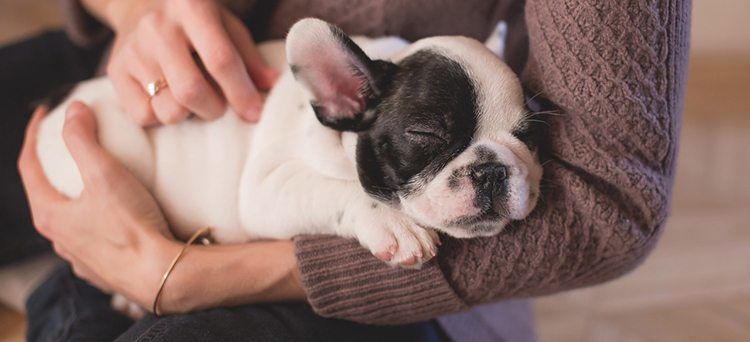A common concern in dogs, especially older spayed females, is a loss of bladder control, urinary incontinence , which results in urine dribbling, especially during sleep. Urinary incontinence is usually a disorder of the storage phase of the bladder. This can be caused by an inability of the bladder to fill properly, a partial outflow obstruction, or an abnormality of anatomy; but it is most often associated with a failure of the urinary sphincter to contract properly.
While older spayed females are most often affected, juvenile females or older neutered males can also be affected. Medium to large breed dogs are also more often affected.
We will briefly deal with some of the less common causes of incontinence before discussing the classical case.
- Nerve damage in the spinal cord can affect bladder control, either by paralyzing the sphincter muscle, or by causing it to be spastic so that urine builds up in the bladder and eventually creates so much pressure that it forces itself out.
- Bladder infections, prostatic infections or enlargement in male dogs, bladder stones or crystals, and tumors can also cause irritation and abnormal urination.
- A spastic bladder may also result in incontinence.
- In young animals, certain birth abnormalities in the urinary anatomy can make normal bladder control impossible.
- In older animals, the ligaments which hold the bladder in a normal position in the abdomen may become loose; the resulting abnormal position of the bladder may interfere with normal control.
For the control over the dog health, the offering of the correct food to eat should be there. The working of the body parts are required to be perfect for healthy growth of the dogs. The abnormal health and position can check here at online search engines and the treatment is done accordingly. The availability of the best CBD products is made available to the pet dogs.
Surgical correction may be helpful in many of these cases. All of these conditions should be ruled out by your veterinarian before deciding that the dribbling is caused by a weak sphincter.
If these less common problems described are ruled out, and it is determined that the problem lies in the sphincter closing the bladder, then several other medical conditions must be considered to be sure that they are not contributing to the problem.
Any condition that results in an increase in urine production will cause the bladder to fill more rapidly, and thus may put more stress on the sphincter during times when the dog is not let out frequently to urinate. The most common conditions responsible for increased urine production would include diabetes, chronic kidney failure, and cushings disease. These should be particularly suspected if increased drinking is also noted. Any dog, especially if older, who begins dribbling should be evaluated by your veterinarian. Blood tests and urine analysis may be required if any of the above problems are suspected. If an underlying reason for the dribbling is found, it should obviously be treated specifically.
If these contributing conditions have been ruled out, the dog may have a primary weakness in the sphincter muscle which holds the bladder shut. The symptoms are typically intermittent, especially to start with. They occur most commonly at night or when the dog is sleeping, because the sphincter muscle tone is lower during periods of relaxation.
Typically, the weakness in the sphincter muscle is at least in part due to a decrease in the number of receptors on the muscle for the nerve transmittor chemicals released by the nerves controlling the bladder. This decrease in receptors is seen when estrogen levels are low, and results in an inability of the sphincter muscle to respond adequately to signals from the spinal cord telling it to contract. During relaxation periods, the nerve signals decrease, so the already inadequate tension in the muscle decreases further, resulting in a psssive and unconscious dribbling of urine. As we explained earlier, if more urine is being produced due to a disease like diabetes, more pressure is placed on the sphincter so the problem is worsened.
If dribbling is secondary to an underlying disease, then the underlying disease should obviously be treated first. Otherwise, if it is decided that the dog has a primary weakness in the sphincter muscle, there are two common ways of treating primary urine dribbling.
- The first is to supplement the dog with drugs that mimic the action of the nerve transmittor chemicals normally released to trigger the muscle. By providing more stimulation, the depleted receptors on the muscle are more fully triggered, and thus the dribbling is often well controlled. The drugs most often used for this are Phenylpropanolamine (previously contained in Ornade decongestant, though now removed from the market in some countries) and Pseodoephedrine (contained is Sudafed and other simular medications).
- The second common treatment for this condition is to supplement with reproductive hormones (most commonly diethylstilbestrol). It has been shown that with hormone replacement, the number of receptor sites increased from its depleted number, and bladder control frequently improves.
With severe cases, a combination of the two treatment types may synergize to give better results.
In conclusion, urine dribbling in dogs, while it is a common and frustrating condition to live with, is frequently very responsive to treatment. Although your veterinarian should be consulted to rule out underlying diseases, the chance of being able to help control your dog’s problem are excellent.







